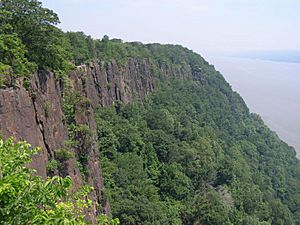Palisades Sill facts for kids

The Palisades Sill is a huge sheet of rock that formed 200 million years ago. It stretches through parts of New York and New Jersey. It's famous for The Palisades, which are tall cliffs rising sharply above the western side of the Hudson River. Because you can see this rock formation so clearly, and it has special features, it's very popular with nature lovers, rock climbers, and geologists (scientists who study rocks).
Where to Find the Palisades Sill
The Palisades Sill is easy to spot because of its tall cliffs along the Hudson River. You can even see it from parts of Manhattan. This rock formation is about 80 kilometers (50 miles) long. Most of it runs right alongside the Hudson River.
It first appears in Staten Island in New York City. Then, it crosses into New Jersey. Many towns like Hoboken, Jersey City, Union City, Fort Lee, and Englewood Cliffs are built on top of it.
How the Palisades Sill Formed

About 200 million years ago, the supercontinent Pangaea started to break apart. This caused huge cracks, or rifts, in the Earth's crust. What is now eastern North America began to pull away from what is now northwestern Africa. This pulling apart created the young Atlantic Ocean.
Deep inside the Earth, hot, melted rock called magma rose up. Some of this magma squeezed into older layers of sandstone and other rocks. This magma then cooled down and became solid rock. Over millions of years, the rocks above the Palisades Sill wore away. This process, called erosion, exposed the sill, allowing us to see it today as the famous cliffs.
The Palisades Sill is about 300 meters (1,000 feet) thick on average. Its famous cliffs rise about 100 meters (300 feet) above sea level. The rock layer slopes gently downwards to the west, about 10 to 15 degrees. Scientists believe the sill formed about 3 to 5 kilometers (2 to 3 miles) underground. Studies also show that the sill was already tilted to its current angle when it formed. This is confirmed by the straight, vertical columns of rock you can see, called columnar jointing.
The basalt flows found in the Watchung Mountains are made from the same type of magma that formed the Palisades Sill. However, the Watchung Mountains magma erupted onto the Earth's surface, while the Palisades Sill magma stayed underground.
Images for kids
-
Photomicrograph of a thin section showing the strong presence of olivine (brightly colored, rounded grains) surrounded by plagioclase and pyroxene grains within the olivine-rich zone. Crossed polars, 40x





